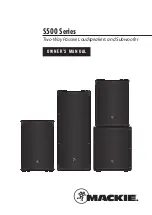
7
To achieve this highly desirable line source behavior, it is essential to have a tall
and slim driver. (Simply stacking multiple “cone & dome” high frequency drivers
does not create a proper line source. Instead, it creates a series of point sources
which end up interfering with each other.) With Wisdom Audio’s planar mag-
netic technology, it becomes possible to have drivers that are extremely tall and
slim. In the LS4, for example, the active area of the tweeter section of the film is
driver is approximately
3
⁄
4
“ (19mm) wide by 80” (203cm) tall.
Because of this shape, the sound (even at high frequencies) is distributed uni-
formly across the width of the room from a driver that “looks” only less than an
inch wide acoustically. However, the sound is launched in a much more direc-
tional way vertically. By minimizing early reflections from the ceiling and the
floor, the clarity of the system is greatly enhanced. This is heard in both tremen
-
dous musical detail and in much-improved dialog intelligibility.
For more detailed information on the loudspeaker drivers in general, and planar
magnetic drivers in particular, please refer to the Planar Magnetic Technology
white paper that can be found on the Wisdom Audio web site, at
www.wisdomaudio.com.
Designed for triamplification
People who have wanted to extract the highest performance from their systems
have known for a long time that driving each section of the speaker directly and
separately yields the finest results. Of course, this requires having a dedicated,
active crossover to divide the frequency range appropriately before the power
amplifiers, so that they can then drive the speakers directly. It also requires two
sets of speaker wires for each loudspeaker.
Biamplification makes use of two channels of amplification to drive different
portions of the audio spectrum. The most common instance of “bi-amping”
today is in home theater applications, wherein a dedicated subwoofer handles
the deepest bass, while the remaining audible range is handled by the various
front and surround speakers. But you can also biamplify other loudspeakers,
driving the low frequency sections separately from the sections that handle the
higher frequencies. Your Wisdom Series LS4 is such a speaker, designed to use
separate amplifiers for the lower and the higher planar magnetic sections of
each loudspeaker.
Since each channel of the amplifier is delivering current into its load only over
a limited range of frequencies, several forms of distortion are reduced as com-
pared to each channel handling the full range of musical information. Moreover,
since each amplifier is “direct-connected” to the driver for which it is respon
-
sible, there are no passive component losses and the amplifier can control the
motion of its assigned transducer with far greater finesse and precision.
In addition, the deepest bass is handled by dedicated subwoofers (usually the
STS). They also have their own amplifiers, making the complete system triampli
-
fied. By being separate from the main LS4 loudspeakers, the subwoofers can
also be located where they will perform best vis-a-vis the standing waves of the
room. In this way, you can optimize placement for both the best imaging and
the best bass performance – something not possible with all-in-one designs.
SC-1 System Controller
In order to realize these benefits, an active crossover must accurately divide the
signal into the low and high ranges. The Wisdom SC-1 System Controller serves
that purpose, while also providing both system-specific parametric equalization
and sophisticated room correction to minimize distortions introduced by the
Summary of Contents for Ls3
Page 1: ...Owner s Manual Wisdom Series LS3 LS4 Biamplified Planar Magnetic Loudspeaker ...
Page 3: ......
Page 22: ...22 LS4 Dimensions ...
Page 23: ...23 LS3 Dimensions ...
Page 24: ...24 Notes ...
Page 25: ...25 Notes ...








































